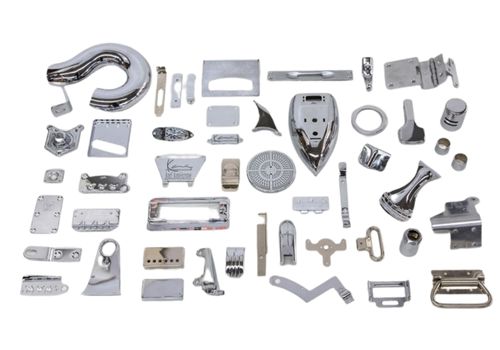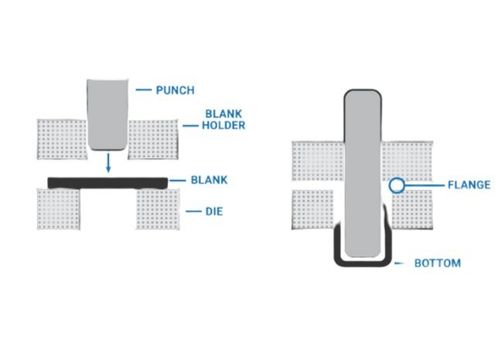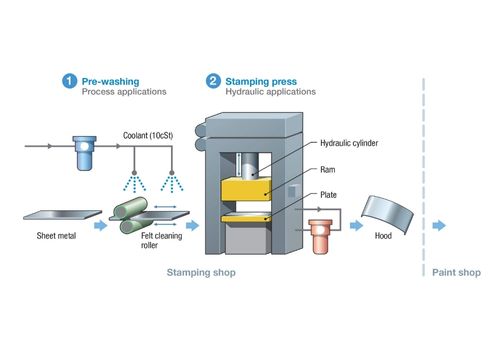
In aluminum stamping, you will use dies and punches to transform blanks into desired shapes.
Metal stamping is a popular, practical, and unique metal fabrication technique. A reason this guide explores everything about stamping aluminum.
Whether you want to choose the best aluminum alloy, stamping technique, or surface finishing; you will find all information you are looking for right here.
Choosing Aluminum Alloy for Metal Stamping
There are many aluminum alloy grades you can use for metal stamping. The choice will depend on your specific application requirements.
Generally, most aluminum grades are a perfect choice for any metal stamping operations. To understand aluminum grades for any metal stamping, let’s look at the table below:
| Aluminum Alloy Grade | Main alloying element |
| 1xxx | 99% pure aluminum |
| 2xxx | Copper |
| 3xxx | Manganese |
| 4xxx | Silicone |
| 5xxx | Magnesium |
| 6xxx | Magnesium and Silicone |
| 7xxx | Zinc |
| 8xxx | Other elements |
Please Don’t get this wrong:
In the table above, it does not imply that those are the only alloying metals/non-metals in the aluminum grades. Of course, there are other metal elements too.
Normally, the “xxx” are numbers. For instance, in the 5xxx series, we may have aluminum 5052, which is good for metal stamping.
In addition to the “xxx”, we also have the letters at the extreme right such as:
- F – it implies fabricated aluminum grade
- O – this is for annealed aluminum alloy
- H – it is for strain-hardened aluminum grade
- W – this is a solution heat-treated aluminum alloy
- T – it refers to thermal and heat-treated tempers for aluminum grades
Remember, this information will help you choose the perfect aluminum for stamping. Generally, there are many aluminum alloys for stamping. The choice will depend on specific application requirements.
Let’s look at some common aluminum grades you choose for metal stamping:
| Aluminum for Metal Stamping | Key Characteristics or Features |
| 1100 | · Good workability · High ductility · Generally soft · Recommended for stamping intricate designs or parts |
| 3003 | · Higher strength than the 1xxx series · Good workability · Excellent corrosion resistance |
| 5052 | · Highest strength than most non-treated aluminum alloy grades · Excellent fatigue strength · High corrosion resistance · Excellent finishing characteristics · Good workability |
| 6061 | · Heat treatable · Excellent corrosion resistance · Good weldability properties · Easily formable |
Still, you can explore other grades for custom aluminum stamping. This is critical when handling specialized applications.

More Resources:
Aluminum Alloy – Source: Wikipedia
Types of Aluminum Alloy – Source: IQS Directory
Types of Aluminum – Source: Thomas Net
Benefits of Stamped Aluminum Parts

Stamping aluminum parts is popular due to their numerous benefits such as:
- Excellent surface finish – stamped aluminum parts have a good surface finish. Additionally, you can add other finishing options such as painting, powder coating, etc.
- High strength-to-weight ratio – the parts are lightweight and offer good strength. A reason aluminum stamped parts are suitable for the aerospace industry
- Excellent thermal conductivity – a property that makes aluminum best for cooking accessories
- Good electrical conductivity – you can use aluminum as an electrical conductor
- Low-temperature resistance – aluminum can maintain its toughness and tensile strength even in low-temperature conditions
- Excellent corrosion resistance – the oxide layer protects the aluminum from harsh environmental conditions
Apart from these, aluminum parts are non-toxic, inherently reflective, and easy to fabricate.
However, even as you stamp aluminum parts, they may be more expensive than other alternatives such as steel. Additionally, welding stamped aluminum parts can be a challenge since it requires other processes.
Lastly, some aluminum alloys are not heat-treatable.
Generally, aluminum has desirable mechanical, physical, and chemical properties for most sheet metal stamping applications.
More Resources:
Metal Stamping – Source: Instructables
Stamping Aluminum – Source: Stamping Journal
Types of Aluminum Stamping Operations and Techniques
Metal stamping is a general term we use to refer to many fabrication techniques. You can use these stamping techniques to transform aluminum sheet metal into any shape.
Among the main techniques for stamping aluminum include:
Blanking Aluminum
During the blanking process, you will use suitable metal stamping tooling to cut a section from aluminum sheet metal.
Dies are popular tooling systems in aluminum blanking operations. Ideally, the blanking operation removed the desired design from the workpiece.
Usually, blanking aluminum and punching aluminum are almost the same. However, it is important to note that, the punching process removes the unwanted part from the aluminum sheet.

Piercing Aluminum
Piercing aluminum uses both punches and dies to form desired shapes on the sheet metal. During metal piercing, you will create holes or notches on blank aluminum sheets.

Coining Aluminum
Coining is an aluminum bending technique. Here, you will place a sheet metal between the punch and die, then apply reasonable force to stamp the aluminum sheet metal.
It is also worth noting that aluminum bending is also an aluminum stamping technique. You can transform aluminum into L, V, or U shapes, depending on the metal stamping requirements.

Aluminum Deep Drawing
Deep drawing helps to form deep depressions on the aluminum surface. You will apply reasonable tensional force, to push aluminum into the cavity.
Although stretching can be a challenge during aluminum deep drawing, most fabricators try to minimize its effects as much as possible.

Embossing Aluminum
In the embossing process, you will form either a recessed or raised pattern on an aluminum surface. You will press a tooling system with the pattern you want on the aluminum surface.

Flanging Aluminum
You will use a specialized metal stamping tool to introduce either flange or flare on the aluminum surface.
Now, whichever aluminum metal stamping technique you opt for, you can conduct the process once or repeatedly. This leads us to another important part of stamping aluminum material – metal stamping operations.
During aluminum metal stamping, you can choose these 4 stamping operations:
1. Aluminum Progressive Die Stamping
In progressive die stamping aluminum, there are a series of dies performing different operations.
That is, as you feed aluminum into the stamping machine, it will conduct a specific operation on the aluminum part. Thereafter, the same section will move to the next die/punch station for another metal stamping operation.
It is a sequential process where the same part will move to the next station. Usually, the last die/punch will separate the final product from the scrap.
Normally, aluminum progressive die stamping is characterized by:
- In most cases the aluminum you want to stamp moves horizontally on the stamping die tooling system
- A perfect stamping technique for long-run production
- Stamping dies will always last longer
- It is a highly repeatable process
2. Aluminum Transfer Die Stamping
As the name suggests, transfer dies stamping involves transporting aluminum part from one stamping station to another mechanically. That is, you may use a robotic system or conveyor belt.
However, aluminum transfer dies stamping is similar to progressive die stamping. The only difference comes when the desired section is removed from the aluminum blank.
That is, during the first station, you will stamp aluminum and separate the section simultaneously. Thereafter, you will transport the section mechanically to the next stamping station.
Usually, transfer die stamping is suitable for very large aluminum parts.
3. Aluminum Four-slide Stamping
At times, you may refer to the process as an aluminum multi-slide stamping process.
If you are planning to stamp complex aluminum parts, then four-slide stamping is a perfect choice for you. It will stamp aluminum using four sliding tools. As a result, it subjects aluminum to multiple deformations.
Depending on the machine configuration, this aluminum sheet metal stamping operation can be low-cost and best for large-scale metal fabrication.
4. Aluminum Fine Blanking
Aluminum fine blanking is also called aluminum fine edge blanking. It produces stamped aluminum parts with high accuracy. The edges are usually very smooth.
In all four operations, you can cut, punch, blank, or punch aluminum. The technique will depend on the final part you want.
More Resources:
Sheet Metal Stamping Parts – Source: KDMFAB
Understanding Metal Stamping – Source: Thomas Net
Deep Draw Metal Stamping – Source: KDMFAB
Stamping – Source: Wikipedia
High-Speed Stamping – Source: KDMFAB
Metal Stamping Technologies – Source: IQS Directory
Industries Using Stamped Aluminum Parts
Today, many industries use stamped aluminum parts for many applications. For instance, you will find stamped aluminum parts in:
- Aerospace industry
- Automotive industry
- Marine industry
- Medical industry
- Electrical and electronics industry
- Lighting industry
- Construction industry
Aluminum Stamping Applications

Aluminum stamping has practical applications in virtually every industry. Take for example:
- 1100 aluminum – flat ware, decorative parts, anodized parts, spun aluminum parts, etc.
- 2024 aluminum – aircraft parts, machine parts, etc.
- 3003 aluminum – kitchen equipment, chemical handling parts, etc.
- 5052 aluminum – home appliances parts, cooking equipment, aircraft parts, etc.
- 6061 aluminum – structural parts, automobile frames, etc.
- 6063 aluminum – architectural structures
- 7075 aluminum – machine, aircraft parts, etc.
As you can see, there is every alloy grade for custom aluminum stamping. Therefore, once you have the specific parts you want, it is easier to choose the correct aluminum for stamping.
There are many aluminum stamped parts such as connectors, spacers, fittings, brackets, housings, plugs, sleeves, heat sinks, panel sections, collars, trays, etc.
Common Problems with Stamping Aluminum Parts

When stamping aluminum, at times you may experience some challenges that may impact the metal fabrication process.
In most cases, the process of stamping aluminum involves:
- Part design – you must design the aluminum parts you wish to stamp.
- Choose a suitable aluminum alloy grade for the stamping process
- Design tooling for the stamping process – today, most companies opt for in-house tooling design
- Choose a reliable aluminum stamping machine to fabricate the parts
- Check the quality of stamped aluminum parts
- All surface finish or coating on aluminum stamped parts
At every stage, you will experience certain challenges. In case you don’t adopt a suitable solution, the cost of stamping aluminum parts may not be sustainable.
With that in mind, let’s look at possible challenges and solutions.
Aluminum Oxide Build Up
The oxide becomes a problem when you want to weld stamped aluminum parts.
Usually, aluminum forms an oxide layer that protects the material from corrosion. When this oxide layer forms, it becomes difficult to weld aluminum material.
Accelerated Stamping Tooling Wear
Tooling wear is mainly due to friction during the aluminum metal stamping process. Over time, you will notice;
- A gradual loss in tooling material
- Visible damages on stamping tooling
Among the key factors that contribute to stamping die and punch tooling wear include:
- Material type for the tooling
- Aluminum sheet metal strength (the material you are stamping)
- Surface finish on the tooling
- Type of lubricant
- Working temperature
- Sliding velocity
You may control these parameters to ensure your tool serves you for a long time. However, at times replacing the metal stamping tooling can be the only option.
Perforating Problems in Aluminum
It is a major challenge when stamping holes on aluminum materials. For instance, you will get holes with an excellent finish in the aluminum 5000 and 6000 series.
However, for aluminum 3000 and 4000 series, there are high chances of shrinkage. Of course, this is due to the soft nature of these aluminum grades for stamping.
As a result, you must adopt a reasonable die clearance. Additionally, you can use a punch with a flat design and sharp edge. The punch should not have a shear angle.
Therefore, whenever you are perforating aluminum, ensure you have reasonable punch-to-die clearance. The clearance will depend on:
- Aluminum alloy grades for stamping
- Tensile strength of aluminum
- Aluminum sheet thickness
Galling Problem in Perforating Aluminum
Aluminum tends to stick on the tooling system during drawing, piercing, trimming, or perforation. As a result, it causes galling.
Galling refers to the accumulation of aluminum material on the tooling system (especially the punch).
Overtime, the aluminum material accumulation will cause adhesion wear and part inconsistency. Therefore, you should consider reducing the coefficient of friction.
Apart from these, you may experience other problems such as wrinkles, splits, spring back, uneven surfaces, and excessive thinning.
KDM Capability in Stamped Aluminum Parts
KDM is your trusted custom aluminum stamping solution provider in China. With our extensive knowledge and experience in aluminum stamping, we can handle all your metal stamping needs.
Whether you want tight tolerances, in-house tooling design, prototype development, or high-scale stamping aluminum parts; you can count on KDM.
Over the years, KDM has adopted various metal stamping techniques, surface finishing, and quality inspection procedures. We guarantee quality and competitive prices on all fabricated aluminum parts.
Stamping Aluminum FAQs
1. What is Aluminum Stamping?
Stamping aluminum is a metal fabrication technique where you use dies to make shapes and patterns on sheet metal.
2. Is Aluminum Good for Stamping?
Yes.
Aluminum exhibits good workability and strength. You can easily transform aluminum into any shape and design.
You can stamp aluminum parts easily.
3. How do you Choose Aluminum Alloy for Metal Stamping?
When choosing aluminum stamping blanks, it is important to consider the following key aspects:
- Practical application – this includes aluminum parts and applications
- Strength
- Degree of corrosion resistance
- Level of formability
- Ease to machine, and weld
- Any other treatments required such as heat treatment
- Possible surface finishing such as painting, powder coating, etc.
- Aluminum material availability
4. Can you Anodize Stamped Aluminum Sheet?
Yes.
For highly corrosive environments, it is important to anodize stamped aluminum parts. Anodizing aluminum will greatly improve the corrosion resistance properties.
Of course, this can work alongside powder coating and painting stamped aluminum parts where necessary.
5. Are there Specific Aluminum Stamping Lubricants?
Yes, there are specific lubricants you can use during aluminum metal stamping. Although there are many brands available, you should consider the following properties:
- Oil-free
- Fully synthetic
- If possible choose a lubricant that is suitable for both light and heavy-duty stamping
6. Are there Specific Stamping Presses for Fabricating Aluminum?
Depending on your stamping operation, you can choose:
- Mechanical stamping presses
- Hydraulic stamping presses
- Mechanical servo stamping presses
The three work well when stamping aluminum.
7. Are there Specialized Dies for Stamping Aluminum?
Aluminum is an easy-to-stamp metal due to its mechanical strength, workability, and formability properties. Actually, you can use normal dies such as plain carbon steel. Of course, there are other materials too.
Again, when it comes to aluminum metal stamping tooling configuration, you can choose:
Single Station Die for Stamping Aluminum
Normally, there are two configurations – namely, combination dies and compound dies.
With the compound dies, you can cut aluminum multi times in one single operation. On the other hand, combination dies can perform non-cutting and cutting operations in a single stroke.
Stamping Aluminum using Multi-station Dies
They are suitable in applications where you wish to fabricate aluminum in sequence. They are perfect for progressive and transfer stamping processes.
Conclusion
Aluminum stamping is a versatile metal fabrication technique that involves many operations and techniques. The best part, you can make hundreds of parts depending on your production requirements.
At KDM, we help you get high-quality, and precise stamped aluminum parts – contact us for any inquiries.




